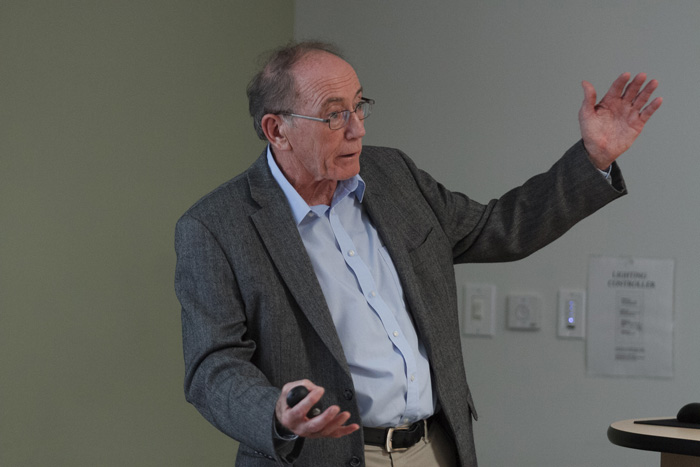Global Warming Witness

Photo by Carl Socolow '77.
2016 Potter Lecture features Lonnie Thompson, a major figure in the discovery and documentation of global warming
by Tony Moore
The 12th annual Potter Lecture recently featured Lonnie Thompson, Distinguished University Professor in the School of Earth Sciences at Ohio State University, who, to quote The New York Times, “essentially discovered the problem of global warming.”
“Just this year, Dr. Thompson has returned from his 61st field expedition,” Associate Professor of Earth Sciences Ben Edwards told the maximum-capacity crowd in his introduction, “so for prospective earth sciences majors, that's something to keep in mind: If you like to see the world, it's not a bad profession.”
The annual Potter Lecture centers on a public discussion and classroom visits, providing students with a chance to meet established professionals in the earth sciences field and learn about their research and careers. Thompson is one of the most notable environmental scientists of the 20th and 21st centuries, and on Monday night, in his talk "Global Climate Change: The Evidence, People and Our Options,” he offered the community an in-depth look into his work and the trajectory of climate change.
"I'm glad to see so many young people here, because that's the future,” said Thompson, an ice-core paleoclimatologist who is also a research scientist at the Byrd Polar and Climate Research Center at Ohio State, where he has taught earth sciences since the 1970s. “I think we have lots of challenges ahead, but there are lots of opportunities as well.”
Thompson—a member of the National Academy of Sciences who was listed in Time magazine’s special 2015 issue “Great Scientists: The Geniuses, Eccentrics and Visionaries Who Transformed Our World”—began his journey into climate change science in the early 1980s, on the Quelccaya ice cap in Peru’s Andes Mountains. His follow-up expeditions around the globe inspired the 2005 book Thin Ice, by science writer Mark Bowen, and led Thompson to conclude that the world’s largest ice bodies are melting.
Ever since, he’s been keeping a record of global climate as seen through ice, saving and storing ice samples from around the world, “some of which will likely be around longer than the glaciers where he got it,” Edwards told the audience.
Thompson detailed the causes and effects of global warming, examined human response (or lack thereof) to it, all while offering an often bleak look at the future of the phenomenon.
“The globe is warming; that debate has come and gone,” he said. “So if we found a new energy source tomorrow and we stopped producing CO2, 100 years from now, 33 percent of the CO2 in the atmosphere would remain. A thousand years from now, there would still be 20 percent.”
But Thompson reminded the crowd that mitigation through means such as alternative energy sources is the only approach for dealing with global warming, as in its wake only come adaptation and finally suffering, for those who cannot escape the effects of the problem.
While this is bleak, the rapt audience was full of students ready to confront problems such as these head-on. And, as Thompson told them, they are the future.
Learn more
Published March 8, 2016